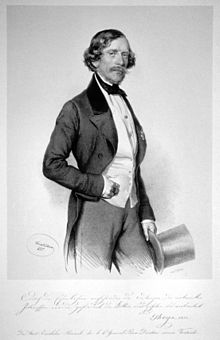Karl Ritter von Ghega or Karl von Ghega (10 January 1802 – 14 March 1860) was an Albanian nobleman and the designer of the Semmering Railway from Gloggnitz to Mürzzuschlag. During his time, he was the most prominent of Austrian railway engineers and architects.[1]
Carl Ritter von Ghega | |
|---|---|
 Carl Ritter von Ghega, drawn by Joseph Kriehuber, 1851 | |
| Born | Carlo Ghega 10 January 1802 |
| Died | 14 March 1860 (aged 58) |
| Resting place | Zentralfriedhof, Vienna |
| Nationality | Austrian |
| Occupation | Engineer |
| Known for | designing and engineering the Semmering Railway |
Biography
editBorn in Venice as Carlo Ghega to an ethnic Albanian family.[2] His father, Anton Ghega, was an officer in the Austrian navy in the government service.[1] He studied in Padua, where he took the examination for doctor of mathematics at the age of 18. He was attached to the Imperial board of Public Buildings when the railway movement commencing throughout Europe attracted his attention.[1] He began his engineering career with road and hydraulic engineering in Venice. Among other things he contributed to the building of the road over Cortina d'Ampezzo to Toblach. From 1836 to 1840 he was a construction supervisor for the railway track from Brno to Břeclav, the so-called Emperor Ferdinand North Railway. During this time, in 1836 and 37 he studied also the railways in England and other European countries. In 1842, entrusted with the entire planning of the future state railway, he made a study trip to North America.
After his return to the state railway he began with the planning of the railway line to the south, from Mürzzuschlag to Graz and Trieste. The crossing of the Semmering was not believed possible, but as early as 1844 he submitted a plan for the crossing of the Semmering, with locomotives without an extra rail for gear wheels. Before the building was fully decided, he began to enforce the construction of locomotives which could overcome such upward gradients. Construction of the Semmeringbahn was begun in 1848 and completed in 1854. In 1856, the Borovnica viaduct, one of the most imposing railroad bridges of the era, was built upon the plans by von Ghega as part of the Austrian Southern Railway from Vienna to Trieste.
Carl von Ghega was next assigned to the building of a railway in Transylvania, but he could not see this project to its end because of his death in Vienna from tuberculosis.
Other sources about origin
editAccording to the authors of Encyclopedia of North American Railroads – page 493, Carl Ritter von Ghega was "An ethnic Italian". According to the source Dictionary of American Family Names - page 31, Ghegan is an Italian surname. According to the source Export: Austrian Architecture in Europe - page 14, ”Despite his family's Italian descent he was raised as an Austrian and grew up speaking three languages (German, Italian, Slovenian)”.
References
edit- ^ a b c The Architect, Volume 3. 175 Strand W.C. 1870. p. 184.
{{cite book}}: CS1 maint: location (link) CS1 maint: location missing publisher (link) This article incorporates text from this source, which is in the public domain. - ^ Paar, Rinaldo (2019). "Carl Ritter von Ghega – 2018 Surveyor of the Year". Kartografija I Geoinformacije. 18 (32): 64. doi:10.32909/kg.18.32.5. S2CID 214043118.
Carl Ritter von Ghega was an Austrian of Albanian extraction, born in Venice (Elsie 2012). His father was Anton Gega, a captain in the Venetian navy. His mother was Anna, nee Pribis. On 24 June 2005, a symposium entitled Carl Gega – Between Legend and Reality was organised by the Albanian Embassy in Vienna. It was demonstrated that Carl Ritter von Ghega was of Albanian extraction. Ghega's ancestors emigrated from Albania to Perast in Montenegro, and from there to Venice. Gjergi Gega was a captain and judge who moved from Albania to Perast. His son, Cristofor, travelled from Perast to Venice, where he became a naval officer. Cristofor Gega (Carl's great-grandfather), had a son, Gasper (Carl's grandfather), who also became a naval officer and captain. Gasper Gega married Laura Iavelli, whose family had run the 'Albanian School' for decades in Venice. They had three children: Anton, Giovananton, and Angele. The eldest, Antonio (Anton) became a captain in the Venetian Navy and was the father of Carl
Further reading
edit- Dinhobl, Günter (2003). Die Semmeringerbahn: der Bau der ersten Hochgebirgseisenbahn der Welt. Wien: Grasl Druck & Neue Medien. p. 228. ISBN 3-486-56743-8. Retrieved 2011-02-20.[permanent dead link]
Regarding personal names: Ritter is a title, translated approximately as 'Sir' (denoting a knight), not a first or middle name. There is no equivalent female form.